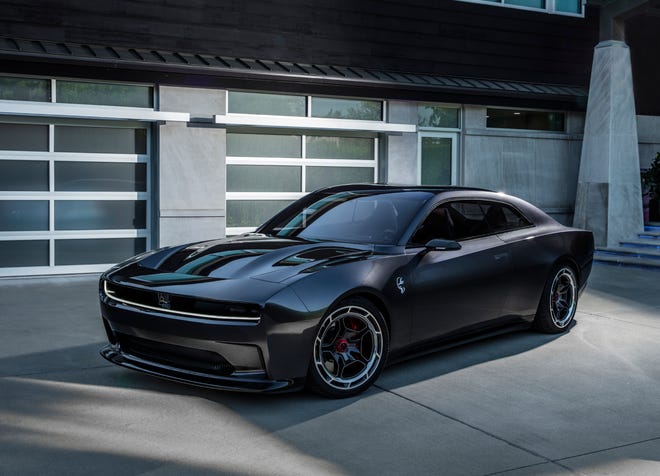Dodge’s electric muscle car concept drops the gas-powered engine that has powered its predecessors, but it doesn’t leave the roar behind.
It also keeps a familiar name alive.
The Dodge Charger Daytona SRT Concept even retains the muscle car appearance.
How much of the look and the extras show up in the muscle car the Stellantis brand brings to market in coming years is anybody’s guess, but brand CEO Tim Kuniskis wants us to see the version, which was unveiled Wednesday at M1 Concourse in Pontiac, as the future. It’s the third and final day of Dodge’s planned Speed Week announcements and follows Tuesday’s unveiling of the 2023 Dodge Hornet, which will offer both gas-powered and plug-in hybrid electric options.
“Some concepts are a science project. This is not a science project,” Kuniskis said of the muscle car.

Specifics were fairly limited when journalists got a peek at the EV during a visit to the company’s U.S. headquarters in Auburn Hills last week. It’s powered by an 800-volt Banshee propulsion system, and promises performance exceeding the SRT Hellcat engine (the 2023 Durango SRT Hellcat promises 710 horsepower and 645 pound-feet of torque, for instance). Like the Hornet, the Daytona also offers PowerShot, a push-button horsepower booster.
The car comes with a “multi-speed transmission with an electro-mechanical shifting experience” and paddle shifters on the steering wheel, in addition to a pistol grip shifter, the company said.
The car offers a couple of nods to Dodge’s history, starting with the Daytona name — a reference, the company noted, to “the first vehicle to break 200 mph on a NASCAR track in 1970.” The “three-pointed Fratzog badge,” which Dodge teased earlier when it said it would produce a battery electric muscle car in 2024, was seen on the brand’s muscle cars from 1962 to 1976, although at that point, the company said, it was “without any meaning or context — until now.”
More:Dodge starts electrified journey with compact Hornet SUV
More:Dodge plans special Charger, Challenger editions as company gears up for production end
More:Stellantis announces plans to build electric Ram 1500, Dodge muscle car in 2024
The look of the vehicle, although sleek and eye-catching, keeps a visual connection with the brand and its design history, even adding a so-called screaming Banshee fender badge that would appear at home in a garage with a Hellcat and a Demon. A rear hatch and fold-flat seats sound like SUV selling points, even if they don’t look the part.
While the front R-Wing — an “aerodynamic pass-through” to bolster “downforce” — is among the notable visual features of this Charger, the sound it delivers is probably more key to the package.
The Fratzonic Chambered Exhaust delivers a sound reminiscent of a low jet-engine hum that can be punched to a wild cat-like roar. No other EVs on the market sound like this, which is the point. The near-quiet of many EVs is what hot rod aficionados assume they’ll have to give up in the electric car era.
Dodge has so connected its image to the experience of the muscle car with its rumble and roaring exhaust notes that a quiet future would be a hard sell for many fans. This 126-decibal system is said to be as loud as a gas-powered Hellcat.
The term EV “exhaust system” might sound questionable and offer a great topic for debate, but Kuniskis described it as an authentic piece of the machine, referencing a pipe organ for comparison. The company’s news release said the exhaust “pushes its one-of-a-kind performance sound through an amplifier and tuning chamber located at the rear of the vehicle.”
Of course, the exhaust notes coming from today’s high-performance gas-powered rides are no accidents either, and the right sound helps elevate the driving experience for those who buy them.
Possible pricing for a future model and electric charge range aren’t available. It’s also not clear where the vehicle will be made. The home of the current gas-powered Charger and Challenger — Brampton Assembly Plant, near Toronto — is scheduled to end production of those models, along with the Chrysler 300, late next year.
As is fairly typical, the company’s announcement on what comes next was rather cagey. It noted in June that Brampton would produce a “flexible architecture to support the company’s electrification plans.”
Those plans, incidentally, have come more into focus in recent months. Stellantis — which also owns the Jeep, Ram, Chrysler, Fiat, Alfa Romeo, Maserati and Peugeot brands — promised, based on the current exchange rate, $30.5 billion (30 billion euros) in electrification-related investments through 2025. The company’s also said it’s targeting more than 70% of sales in Europe and 40% of sales in the United States to be low-emission vehicles by 2030. Later this year, the company is expected to show a version of its planned electric Ram pickup.
Contact Eric D. Lawrence: elawrence@freepress.com. Follow him on Twitter: @_ericdlawrence. Become a subscriber.
